食品インクルージョン市場:現状分析と予測(2024年~2032年)
種類別(チョコレート、フルーツ&ナッツ、シリアル、フレーバーシュガー&キャラメル、菓子、その他);用途別(シリアル製品、スナック&バー、ベーカリー製品、乳製品&冷凍デザート、チョコレート&菓子製品、その他);地域別(北米、欧州、アジア太平洋、その他地域);地域/国別
食品インクルージョン市場規模と予測
食品インクルージョン市場は、2023年に約123億米ドルと評価され、予測期間(2024年~2032年)中に約7%の堅調なCAGRで成長すると予想されています。特に、世界の食品インクルージョン市場は、健康に対する消費者の関心の高まり、機能性および革新的な食品製品に対する消費者の意識の向上、天然およびラベルに優しい食品成分の拡大などの要因によって刺激されています。
食品インクルージョン市場分析
食品インクルージョンとは、食品の食感、味、または官能特性を高めるために、さまざまな食品製品に追加される成分のことです。食品インクルージョンは、食品製品の感覚的な特性を高めるのにも役立ちます。レストランやホテルの数の増加も、さまざまな食品製品を増加させ、食品インクルージョンの需要の増加につながっています。さらに、都市化の進展とライフスタイルの変化が、食品インクルージョンの市場成長の重要な理由となっています。
 食品インクルージョン市場のトレンド
食品インクルージョン市場のトレンド
このセクションでは、当社の調査専門家が特定した食品インクルージョンセグメントに影響を与える主要な市場トレンドについて説明します。
業界を変革するチョコレートセグメント
種類に基づいて、市場はチョコレート、フルーツ&ナッツ、シリアル、フレーバーシュガー&キャラメル、菓子、その他に分類されています。これらのうち、チョコレートセグメントは食品インクルージョン市場で大きなシェアを占めています。チョコレートには多くの用途があり、多くの食品に使用されており、液体、固体、半固体のさまざまな形で入手できます。さらに、チョコレートは人々に人気があり、味を高めるものとして、また食品の装飾にも使用されています。
北米が市場の大きなシェアを占める
2023年、北米は世界の食品インクルージョン市場で最も急速な成長を遂げると予想されています。一人当たりの所得が高い人々が存在することに加え、地域での健康食品に対する需要が継続的に高まっていることが、同地域における食品インクルージョン市場の成長の要因となっています。北米の食品インクルージョン市場は、ベーカリー&菓子、乳製品、スナック製品などの食品製品における食感、風味、栄養価の向上に対する需要の増加によって推進されています。これらの成分には、ナッツ、フルーツチャンク、チョコレートチップ、グラノーラなどがあり、主に味と健康の面で価値を高めています。より多くの成長機会は、クリーンラベルおよび植物由来の製品への傾向の高まりから生まれています。その他には、新製品の発明や機能性食品の摂取量の急増などがあります。主要な業界プレーヤーは、市場の変化する需要に合わせて製品とサービスの多様化を目標としており、それが持続可能な市場の成長を促進します。

食品インクルージョン業界の概要
食品インクルージョンは競争が激しく、グローバルおよび国際的な市場プレーヤーが多数存在します。主要なプレーヤーは、パートナーシップ、合意、コラボレーション、新製品の発売、地理的拡大、M&Aなど、市場での存在感を高めるためにさまざまな成長戦略を採用しています。市場で活動している主要なプレーヤーには、Cargill、ADM、Barry Callebaut、Kerry Group PLC、Tate and Lyle、AGRANA Beteiligungs-AG、Sensient Technologies Corporation、Puratos、Balchem Inc.、Taura Natural Ingredients Ltd.などがあります。ハイテクで革新的な製品/テクノロジーで顧客を容易にするために、これらのプレーヤーによっていくつかのM&Aがパートナーシップとともに実施されています。
食品インクルージョン市場レポートの範囲

このレポートを購入する理由:
- この調査には、認証された主要な業界専門家によって検証された市場規模と予測分析が含まれています。
- このレポートは、業界全体のパフォーマンスの概要を一目で示しています。
- このレポートは、主要なビジネス財務、製品ポートフォリオ、拡張戦略、および最近の開発に主な焦点を当てて、著名な業界ピアの詳細な分析を網羅しています。
- 業界で普及している推進要因、制約、主要なトレンド、および機会の詳細な調査。
- この調査は、さまざまなセグメントにわたる市場を包括的に網羅しています。
- 業界の地域レベル分析の詳細な分析。
カスタマイズオプション:
グローバル食品インクルージョンは、要件またはその他の市場セグメントに応じて、さらにカスタマイズできます。これに加えて、UMIは、お客様が独自のビジネスニーズを持っている可能性があることを理解しています。そのため、お客様の要件に完全に適合するレポートを入手するには、お気軽にお問い合わせください。
目次
食品インクルージョン市場分析(2022年~2032年)の調査方法
世界の食品インクルージョン市場の過去の市場を分析し、現在の市場を推定し、将来の市場を予測することは、世界の主要地域における食品インクルージョンの採用を構築し分析するために行われた3つの主要なステップでした。過去の市場数値を収集し、現在の市場規模を推定するために、徹底的な二次調査が実施されました。次に、これらの洞察を検証するために、多数の調査結果と仮定が考慮されました。さらに、世界の食品インクルージョン市場のバリューチェーン全体にわたる業界の専門家との広範な主要インタビューも実施されました。主要インタビューを通じて市場数の仮定と検証を行った後、完全な市場規模を予測するためにトップダウン/ボトムアップアプローチを採用しました。その後、市場の内訳とデータの三角測量の手法を採用して、業界のセグメントおよびサブセグメントの市場規模を推定および分析しました。詳細な方法論を以下に説明します。
過去の市場規模の分析
ステップ1:二次情報源の詳細な調査:
年次報告書と財務諸表、業績プレゼンテーション、プレスリリースなどの企業内部の情報源、およびジャーナル、ニュースと記事、政府出版物、競合他社の出版物、セクターレポート、サードパーティのデータベース、およびその他の信頼できる出版物を含む外部の情報源を通じて、食品インクルージョン市場の過去の市場規模を取得するために、詳細な二次調査を実施しました。
ステップ2:市場セグメンテーション:
食品インクルージョンの過去の市場規模を取得した後、主要地域のさまざまなセグメントとサブセグメントに関する過去の市場の洞察とシェアを収集するために、詳細な二次分析を実施しました。主要なセグメントは、タイプ、アプリケーション、地域など、レポートに含まれています。さらに、その地域におけるテストモデルの全体的な採用を評価するために、国レベルの分析を実施しました。
ステップ3:要因分析:
さまざまなセグメントとサブセグメントの過去の市場規模を取得した後、食品インクルージョン市場の現在の市場規模を推定するために、詳細な要因分析を実施しました。さらに、タイプ、アプリケーション、食品インクルージョンの地域などの従属変数と独立変数を使用して要因分析を実施しました。世界の食品インクルージョン市場セクターにおけるトップパートナーシップ、合併と買収、事業拡大、製品発売を考慮して、需要と供給側のシナリオの徹底的な分析を実施しました。
現在の市場規模の推定と予測
現在の市場規模の決定:上記の3つのステップからの実行可能な洞察に基づいて、現在の市場規模、世界の食品インクルージョン市場の主要なプレーヤー、およびセグメントの市場シェアに到達しました。必要なすべてのパーセンテージシェア分割と市場の内訳は、上記の二次的なアプローチを使用して決定され、主要なインタビューを通じて検証されました。
推定と予測:市場の推定と予測のために、ドライバーとトレンド、制約、および利害関係者が利用できる機会を含むさまざまな要因に重みが割り当てられました。これらの要因を分析した後、関連する予測手法、つまりトップダウン/ボトムアップアプローチを適用して、世界の主要市場全体でさまざまなセグメントとサブセグメントについて2032年の市場予測に到達しました。市場規模を推定するために採用された調査方法には、以下が含まれます。
収益(米ドル)の観点からの業界の市場規模、および国内の主要市場全体での食品インクルージョンの採用率
市場セグメントとサブセグメントのすべてのパーセンテージシェア、分割、および内訳
提供される製品の観点から見た世界の食品インクルージョンの主要なプレーヤー。また、急速に成長している市場で競争するためにこれらのプレーヤーが採用した成長戦略
市場規模とシェアの検証
主要な調査:主要地域全体で、トップレベルのエグゼクティブ(CXO / VP、セールスヘッド、マーケティングヘッド、オペレーションヘッド、地域ヘッド、カントリーヘッドなど)を含むキーオピニオンリーダー(KOL)との詳細なインタビューを実施しました。次に、主要な調査結果を要約し、述べられた仮説を証明するために統計分析を実行しました。主要な調査からのインプットは、二次的な調査結果と統合され、それによって情報が実行可能な洞察に変わりました。
さまざまな地域における主要参加者の分割

市場エンジニアリング
データ三角測量の手法を採用して、全体的な市場の推定を完了し、世界の食品インクルージョンの各セグメントおよびサブセグメントの正確な統計数値に到達しました。世界の食品インクルージョン市場のタイプ、アプリケーション、および地域におけるさまざまなパラメーターとトレンドを調査した後、データをいくつかのセグメントとサブセグメントに分割しました。
世界の食品インクルージョン市場調査の主な目的
グローバルフードインクルージョンの現在および将来の市場動向は、調査で正確に指摘されました。投資家は、調査で実施された定性的および定量的分析に基づいて、投資に対する裁量に基づいた戦略的な洞察を得ることができます。現在および将来の市場動向は、地域レベルでの市場の全体的な魅力を決定し、産業参加者が未開拓の市場を活用してファーストムーバーの優位性から利益を得るためのプラットフォームを提供しました。調査のその他の定量的な目標は次のとおりです。
- 価値(米ドル)の観点から、食品インクルージョン市場の現在および予測市場規模を分析します。また、さまざまなセグメントとサブセグメントの現在および予測市場規模を分析します。
- 調査のセグメントには、タイプ、アプリケーション、および地域の分野が含まれます。
- 食品インクルージョンの規制の枠組みを定義および分析する
- さまざまな仲介業者の存在に関連するバリューチェーンを分析するとともに、業界の顧客と競合他社の行動を分析します。
- 主要地域の食品インクルージョン市場の現在および予測市場規模を分析します。
- レポートで調査された地域の主要な国には、アジア太平洋、ヨーロッパ、北米、および世界の残りの地域が含まれます
- 食品インクルージョン市場の企業プロファイルと、急速に成長している市場で持続するために市場プレーヤーが採用した成長戦略。
- 業界の地域レベルの詳細な分析
よくある質問 よくある質問
Q1:世界のフードインクルージョン(食の包摂)の現在の規模と成長の可能性は?
Q2: グローバルな食品インクルージョンの成長を促進する要因は何ですか?
Q3: タイプ別で、世界のフードインクルージョンにおいて最大のシェアを占めるセグメントはどれですか?
Q4:グローバルな食のインクルージョンにおける新たなテクノロジーとトレンドは何ですか?
Q5:世界のフードインクルージョンを支配するのはどの地域ですか?
関連 レポート
この商品を購入したお客様はこれも購入しました











